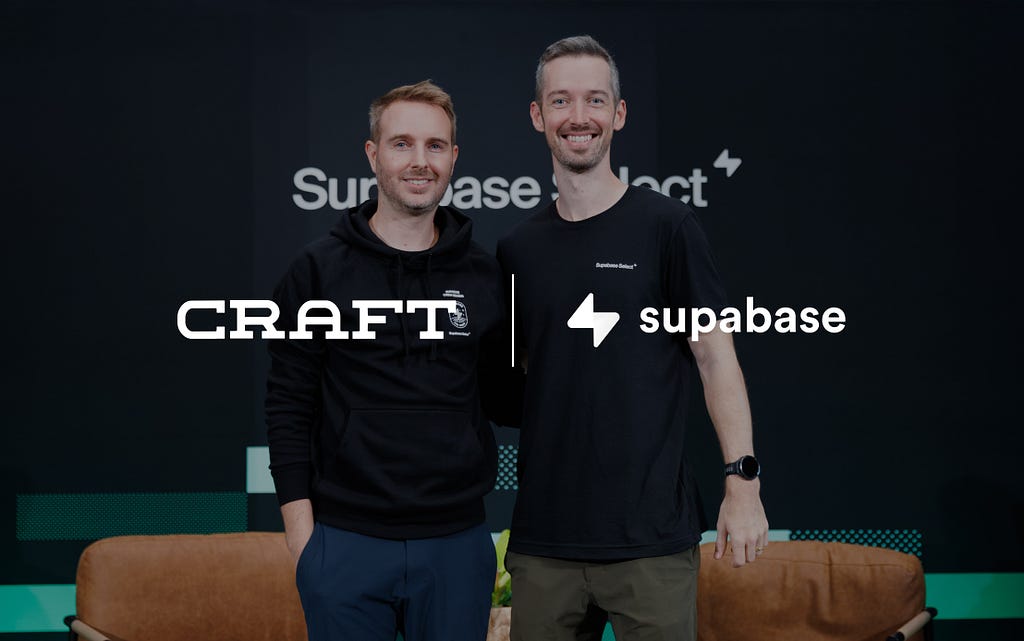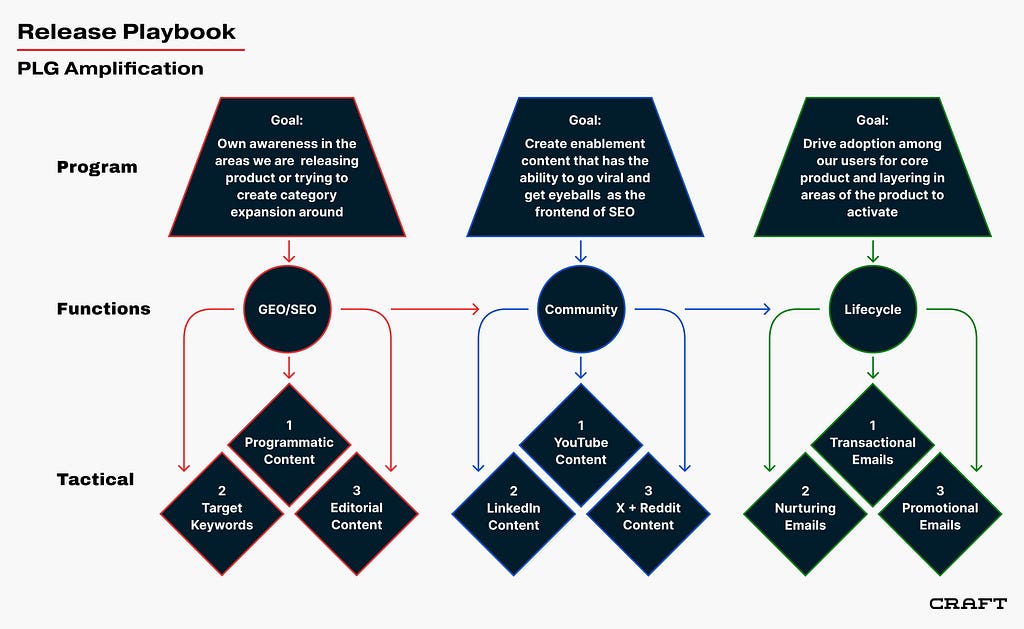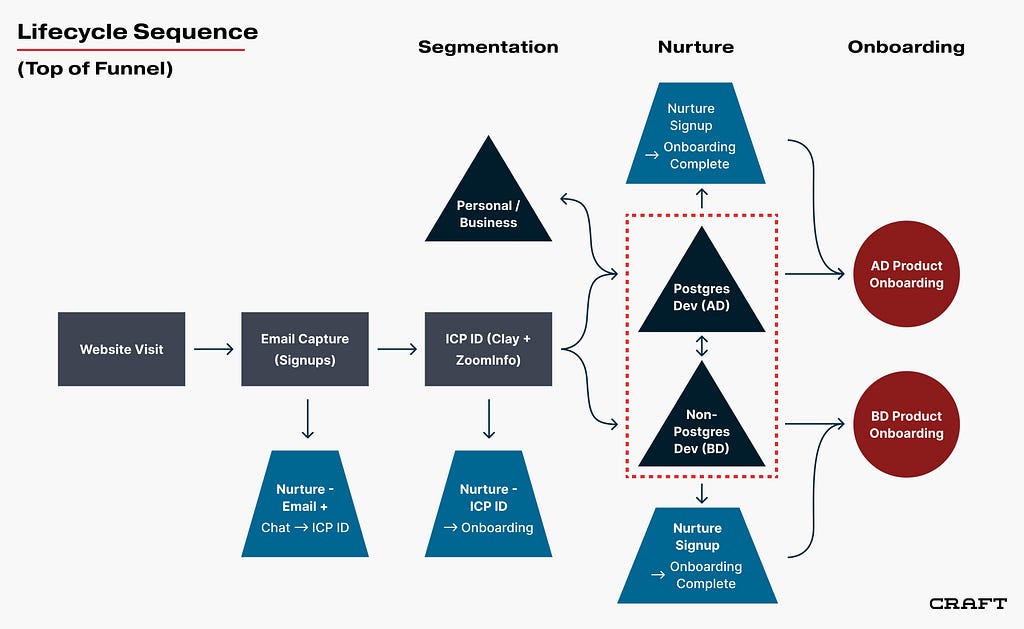
Supabase is one of the most explosive, beloved developer products we’ve seen at Craft. When I say explosive, I mean Supabase rocketed from 1M to over 4.5M developers in less than a year — that kind of scale is unprecedented in developer products and reflects the precision, discipline, and authenticity of a product and community built by developers, for developers. At Craft I’ve embedded into a number of portfolio companies as an interim Marketing & Growth executive as Operator-in-Residence (OIR). Most recently, I did this at Supabase.
When I met Paul back in May 2024 (Co-Founder and CEO at Supabase), I was blown away. His clarity of vision and relentless focus came from an innate desire to help developers. A developer himself, Paul and the entire team combine technical depth with a genuine commitment to open-source and community — values that are the foundation of Supabase’s breakout growth. Since Craft’s initial investment, I’ve supported Paul and the team on growth experiments, lifecycle design, and marketing foundations. This year, we decided I’d go deeper, embedding full-time for four months to help codify their viral growth.
I partnered with Craig (Head of Marketing & DevRel), Ant (Co-Founder & CTO) and Rory (CCO/COO) to create a sharp-shooting organic growth machine. Supabase powers millions of databases worldwide, with tens of thousands created every day, making it one of the fastest-growing open-source developer platforms ever built. For more on Supabase’s growth through a strategic finance lens, read Craft investor Zao Chen’s deep dive after serving as interim VP Finance at the company.
As for my time at Supabase, here are my top three takeaways:
- Devs have a high bar for community. Supabase proved that authenticity, open-source ethos, and developer-first culture aren’t just nice-to-haves, they’re moats.
- There’s always one event that matters. For Supabase, focusing on initialization — getting a database created — is the unlock that drives activation and downstream growth.
- Bifurcating your core ICP groups is essential. Supabase’s lifecycle hinged on serving two distinct groups differently: Postgres-familiar developers and those brand new to databases.
I joined at a pivotal moment: the company had just launched General Availability, which transformed it from a beloved Firebase alternative to the go-to Postgres platform at scale. Now we had to codify Supabase’s growth systems: lifecycle funnels, cohort-based monetization frameworks, and community distribution loops.
Last week, Supabase announced its $5 billion Series E — a milestone that reflects not only the strength of its product and community, but also the scalable growth engine now in place. Here’s how we helped turn developer love and viral adoption into a repeatable growth system:
Takeaway 1: Developers Have a High Bar for Community

“Evergreen” PLG takeaway: Winning in GEO/SEO, Community and Lifecycle requires a multi-threaded effort between each respective function, both at the program and tactical level.
From day one, Supabase was built on community trust. It grew into one of the most starred open-source projects on GitHub, scaling from early Hacker News buzz to powering millions of databases. By summer 2025, it had become both the default backend for serious Postgres developers (many using Supabase alongside Cursor and Claude Code and other AI coding products) and the infrastructure behind the vibe coding boom (i.e. Bolt, Figma Make, Lovable, v0). The takeaway is clear: authenticity and open-source ethos aren’t marketing fluff in developer markets — they are the moat.
What We Did
- Established Supabase’s brand voice guide across docs, lifecycle emails, and YouTube — maintaining the authenticity that the community expected.
- Built frameworks to transform tutorials, docs, and videos into distribution loops, turning education into content-led growth.
- Designed lifecycle journeys that converted open-source contributors and signups into long-term users without breaking community trust.
- Mapped Supabase’s role in the “vibe coding” wave, speaking to both core Postgres developers as well as AI-native builders using Supabase alongside vibe coding.

Why We Did It
Supabase had the opportunity to lean into its open-source transparency and grassroots adoption, giving them an advantage.
At the same time, the developer landscape was shifting. Vibe coding was no longer a fringe movement; it was becoming a mainstream pathway for new builders. Supabase was uniquely positioned to straddle both worlds: a trusted, Postgres-first platform for technical teams coding with AI, and a creative, AI-powered backend for the new generation of vibe coders.
Impact
- Supabase’s community scaled to millions of developers and more than a million active databases — cementing its position as one of the fastest-growing developer platforms.
- 55% of the most recent YC batch and more than 1,000 YC companies total use Supabase for their backend, validating its “default choice” status.
- Supabase became the backend behind many of the top vibe coding platforms.
- The company proved that community isn’t just engagement — it’s a distribution system that drives credibility with enterprises and virality with startups.
Takeaway 2: There’s Always One Event That Matters Most

“Evergreen” PLG takeaway: The “pillar” activation event is the one that makes all others possible. This will either be or lead to the industry standard “aha” moment. Simplify your focus.
For Supabase, the single most important event was initialization, or creating a database. Everything downstream depended on it. Once a developer spun up a database, the odds of them exploring Auth, Storage, Realtime, or Postgres extensions rose dramatically. Focusing on this action turned a broad funnel into a sharp point of leverage.
What We Did
- Re-oriented all funnel metrics around database creation as activation milestone
- Simplified onboarding to reduce friction and guide users to “create your first database” as quickly as possible.
- Designed lifecycle campaigns that celebrated initialization, then nudged users into next steps like enabling Auth or connecting APIs.
- Built activation benchmarks where success was measured by the percentage of users reaching initialization.

Why We Did It
Launches drive attention, but sustainable growth comes from activation. By locking onto database creation as the true north, we turned product adoption into a repeatable system. Initialization wasn’t just an onboarding step, it was the gateway into Postgres and the full Supabase ecosystem.
Impact
- Establishing this keystone event provided a durable framework where retention, expansion, and revenue scale predictably.
- Initialization served as the gateway event that pulled developers into Auth, Storage, and Realtime adoption. Anchoring around this keystone event created a durable framework that connected activation to retention, expansion, and revenue.
- Improved onboarding engagement by guiding users straight to database creation.
- Tracking initialization rates instead of raw signups gave Supabase a reliable leading indicator for growth.
Takeaway 3: Use “Rule of Two” for Your Core ICP Groups

“Evergreen” PLG takeaway: Split out your funnel by starting with Beginners (B) and Advanced (A) users. Follow a two-way split for every segmentation after to avoid getting complicated.
Supabase users fell into two distinct camps: developers already familiar with Postgres, who needed confidence in product readiness, and those new to databases altogether, who needed reassurance that they could succeed quickly. Both loved Supabase, but they engaged in different ways and required different support. Success depended on building systems that treated them separately, rather than forcing a one-size-fits-all path.
What We Did
- Built ICP + use case frameworks mapping the needs, pain points, and upgrade paths.
- Designed lifecycle campaigns and onboarding flows tailored to each audience: advanced prompts for Postgres pros versus step-by-step tutorials for newcomers.
- Layered growth experiments (e.g., Free → Pro conversions, Teams upgrades) differently across each ICP cohort.

Why We Did It
By splitting ICP groups, Supabase could meet each on their own terms. For Postgres-familiar devs, messaging emphasized scale, reliability, and advanced Postgres features. For newcomers, campaigns leaned on simplicity, community support, and “get started in minutes.” The result was a growth engine that could serve both audiences with precision and without compromise.
Impact
- Targeted journeys for each ICP improved activation and conversion.
- Monetization exercises revealed clear ARR upside across distinct segments.
- Established a scalable model where Supabase could serve both enterprise-grade developers and first-time builders without diluting its brand.
Takeaways for Founders
1. Community is a moat, not a channel.

At Supabase, community wasn’t an accessory to growth — it was the growth engine itself. From GitHub stars and core developer community around its open-source software (OSS), to many of the top vibe coding platforms (i.e. Bolt, Figma Make, Lovable, v0), the company’s ability to build authentic trust created distribution, credibility, and virality. Founders take note: communities– especially developer communities–have a high bar for authenticity that no paid marketing campaign can ever deliver.
2. Focus on your unique keystone event.

Supabase’s entire funnel became sharper when we aligned around initialization (aka creating a database) as the single activation event. Founders often get focused on a myriad of metrics like signups, traffic, or vanity metrics, but the reality is that every business has one keystone event that drives compounding growth. Find it, orient around it, and measure success against it.
3. Don’t force one-size-fits-all ICPs.

Supabase saw success with splitting its lifecycle between Postgres developers and those new to databases. Each group engaged differently, needed different onboarding, and converted along separate paths. Treating them the same would have slowed growth. Founders should identify their own “rule of two” — the natural split in their customer base — and design tailored experiences. This precision will help you scale more quickly.
Takeaways for Marketers
1. Codify brand voice early.

At Supabase, one of the first moves was codifying its brand voice early and making it consistent. For developers especially, tone is everything: too salesy and you lose credibility, too dry and you lose attention. Supbase differentiated itself from the start by making their internal meme obsession central to their brand. It was authentic and natural, which made it easier to execute. A similar tone followed, which was also familiar and unforced: since most people on the team are developers, former developers, or technical operators, it came naturally.
2. Lifecycle is where community gets operationalized.

Supabase’s community wasn’t just on GitHub or Discord — it was reflected in content and lifecycle campaigns across all channels that met developers where they were. Initialization prompts, reactivation nudges, and referral loops were written in the same authentic voice that the community had come to trust. Marketers should view lifecycle as the bridge between community energy and product adoption: it’s how you take the goodwill of an open-source movement and turn it into sustained usage and retention.
3. DevRel is how you scale community credibility.

For Supabase, DevRel wasn’t just about SEO rankings or tutorials. Each blog, YouTube video, and doc became proof of community-led, technical expertise — showing developers that Supabase understood their workflows and pain points. This made content both an educational resource and a credibility signal that fueled word-of-mouth from external sources.
In summary, Supabase’s spectacular rise to a $5B Series E wasn’t the result of chance. It was the convergence of three forces: a community that scaled to millions worldwide, a sharp focus on the one event that mattered (initialization), and a disciplined approach to ICP journeys. Together, those things turned developer love into durable growth.
My biggest takeaway: in developer-first companies, the product and DevRel catalyze the movement — but it’s the systems around community, lifecycle, and ICP precision that turn that ignition into a growth engine
Inside Supabase’s Breakout Growth: Lessons Scaling to 4.5M+ Devs, Powering AI & Vibe Coding was originally published in Craft Ventures on Medium, where people are continuing the conversation by highlighting and responding to this story.